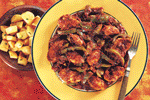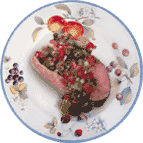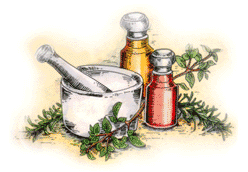|
- Cabbage
- "Bandh Gobhi" or "Patta Gobhi" in Urdu -
is the common market cabbage (Brassica olercaea) with a large, firm spherical head of tightly packed pale green waxy leaves; flat and conical heads are also available; also known as the common cabbage. Other varieties include white and red.
- Candied Peel
- "Narang Ka Chilka" in Urdu -
is a candied peel made from, oranges, lemons, or grapefruits which makes a deliciously fresh, zesty treat.
- Canteloupe
- "Kharbooza" in Urdu -
is a \muskmelon with a raised netting over a smooth grayish-beige skin, pale orange flesh, large seed cavity with many seeds and a sweet, refreshing, distinctive flavor; also known as a netted melon or nutmeg melon.
- Capsicum
- "Shimla Mirch" in Urdu -
along with paprika, red pepper and cayenne pepper, as well as chillies and 'bell' peppers are all from the large Capsicum pepper family. This extensive family encompasses the mild 'sweet' or 'bell' pepper to the hottest 'chilli' peppers which are often ground up to make 'hot' condiments.
- Caraway Seeds
- "Shahi Zeera" or "Kaala Zeera" in Urdu -
are small, brown and crescent shaped with lengthwise ridges. The seeds taste like licorice and are used in cakes, main dishes, and rye breads.
- Cardamom
- "Ilaichi" or "Sufaid Ilaichi" in Urdu -
is a Pakistani and Indian herb, Elettaria cardamomum; The aromatic seed of this plant, used as a spice in Asian cuisine, baking, and in curry powder.
- Carom Seeds
- "Ajwain" in Urdu -
is the small seed-like fruit similar to that of the Bishop's Weed plant, egg-shaped and grayish in colour. The plant has a similarity to parsley. Because of their seed-like appearance, the fruit pods are sometimes called ajwain seeds or mistakenly as bishop's weed seeds.
- Carrot
- "Gaajar" in Urdu -
due to its horn-like shape is a root vegetable, usually orange in colour, though purple, red, white, or yellow.
- Cashew
- "Kaaju" in Urdu -
are sweet, buttery, kidney-shaped nuts that grow from the bottom of the tropical cashew apple. The shells are toxic and always removed before the nuts are marketed. They are sold blanched, plain or toasted and are eaten out of hand; a popular ingredient in many Chinese dishes.
- Cashewnut
- "Kaaju" in Urdu -
are sweet, buttery, kidney-shaped nuts that grow from the bottom of the tropical cashew apple. The shells are toxic and always removed before the nuts are marketed. They are sold blanched, plain or toasted and are eaten out of hand; a popular ingredient in many Chinese dishes.
- Cassia Leaf
- "Tezz Patta" in Urdu -
also sometimes called "Bay Leaf" even though they belong to a totally different botanical family and look nothing like a bay leaf. Cassia leaves can be twice the size (both in width and length) of the European bay leaf and when dried turn a dull brown colour and are inclined to break whereas bay leaves, tough and leathery as they are, are more likely to survive the drying process intact.
- Caster Sugar
- "Pisi Huwi Cheeni" in Urdu -
is granulated sugar that has been sifted to have a finer crystal size, so that it can be shaken out of the holes of a caster.
- Cauliflower
- "Phool Gobhi" in Urdu -
is one of several vegetables in the species Brassica oleracea, in the family Brassicaceae. It is an annual plant that reproduces by seed. Typically, only the head (the white curd) is eaten while the stalk and surrounding thick, green leaves are used in vegetable broth or discarded.
- Cayenne Pepper
- "Lal Mirchi" in Urdu -
also known as "Guinea Pepper", "Bird Pepper" or, especially in its powdered form, "Red Pepper" is a hot, red chili pepper used to flavor dishes and for medicinal purposes.
- Celery
- "Ajmud" in Urdu -
is a widely cultivated herb with aromatic leaf stalks that is eaten raw or cooked.
- Confectioner's Sugar
- "Cheeni Ka Powder" or "Shakkar Ka Powder" in Urdu -
also known as "Powdered Sugar" or "Icing Sugar", is very fine powdered sugar. When intended for home use, it typically contains a small amount of anti-caking agent.
- Cottage Cheese
- "Paneer" in Urdu -
is a fresh cheese common in South Asian cuisine, is an unaged, acid-set, non-melting farmer cheese made by curdling heated milk with lemon juice or other food acid. Unlike most cheeses in the world, the making of paneer does not involve rennet as the coagulation agent, thus making it completely lacto-vegetarian and providing an important source of protein.
- Chicken
- "Murghi" in Urdu -
is a domesticated fowl. As one of the most common and widespread domestic animals, and with a population of more than 24 billion in 2003, there are more chickens in the world than any other bird.
- Chicken Broth
- "Murgh Ki Yakhni" or "Murgh Ka Shorba" in Urdu -
also called "Chicken Stock" is a liquid in which chicken bones and meat are simmered to make a juice. It is used as a basis for other edible liquids such as soup, gravy, or sauce. It can be eaten alone or with garnish.
- Chicken Stock
- "Murgh Ki Yakhni" or "Murgh Ka Shorba" in Urdu -
also called "Chicken Broth" is a liquid in which chicken bones and meat are simmered to make a juice. It is used as a basis for other edible liquids such as soup, gravy, or sauce. It can be eaten alone or with garnish.
- Chick Pea
- "Kabuli Chana" in Urdu -
is also called garbanzo bean, indian pea, ceci bean, bengal gram and is an edible legume of the family Fabaceae, subfamily Faboideae. Chickpeas are high in protein and one of the earliest cultivated vegetables. 7,500-year-old remains have been found in the Middle East.
- Chick Pea Flour
- "Besan" in Urdu -
is a flour made by grinding up dried chick peas. Also known as "garbanzo flour".
- Chili
- "Mirch" in Urdu -
is a spicy fresh or dried fruit of any of several cultivated varieties of capsicum, used especially to add heat, or as a flavouring in cooking.
- Chili Pepper
- "Mirch" in Urdu -
is a spicy fresh or dried fruit of any of several cultivated varieties of capsicum, used especially to add heat, or as a flavouring in cooking.
- Cilantro
- "Hara Dhania" in Urdu -
and also called Coriander Leaf, is a young leaf of the coriander plant, this herb is popular in Middle Eastern, Mexican, and Asian cooking as a cooling counterpoint to fiery spices. The taste is a mix of parsley and citrus.
- Cinnamon
- "Dal Cheeni" in Urdu -
is the bark of a tree with a sharp, sweet taste and is used whole in hot oil to flavour curries and pulaos.
- Citric Acid
- "Tatri" in Urdu -
is a weak organic acid, and it is a natural preservative and is also used to add an acidic, or sour, taste to foods and soft drinks. In biochemistry, it is important as an intermediate in the citric acid cycle and therefore occurs in the metabolism of virtually all living things.
- Clarified Butter
- "Ghee" in Urdu -
is anhydrous milkfat rendered from butter to separate the milk solids and water from the butterfat. Typically, it is produced by melting butter and allowing the different components to separate by density.
- Clay Oven
- "Tandoor" in Urdu -
is a cylindrical clay oven used in cooking and baking. The tandoor is used for cooking in Pakistan, Afghanistan, India, Turkey, Iran, Armenia, the Transcaucasus, the Balkans, the Middle East, Central Asia as well as Burma and Bangladesh.
- Clove
- "Loung" in Urdu -
is the aromatic dried flower bud of a tree in the family Myrtaceae. Cloves are native to Indonesia and used as a spice in cuisines all over the world.
- Cluster Beans
- "Guar Phali" in Urdu -
is an annual legume and the source of guar gum. It grows best under conditions with frequent rainfall, but tolerates arid conditions well. 80% of world production occurs in India, but, due to strong demand, the plant is being introduced into new areas.
- Coconut
- "Naariyal" or "Khopra" in Urdu -
is the fruit of the coconut palm, Cocos nucifera, having a fibrous husk surrounding a large seed; The hard-shelled seed of this fruit, having white flesh and a fluid-filled central cavity; The edible white flesh of this fruit is the coconut palm.
- Coconut Oil
- "Naariyal Ka Tail" or "Khopray Ka Tail" in Urdu -
is extracted from the kernel or meat of matured coconut harvested from the coconut palm (Cocos nucifera). Throughout the tropical world it has provided the primary source of fat in the diets of millions of people for generations.
- Colocasia
- "Arvi" in Urdu -
also known as "Tarro" or "Dasheen", is a genus of 25 or more species of flowering plants in the family Araceae, native to tropical Polynesia and southeastern Asia.
- Colocasia Leaves
- "Arvi Ke Pattay" in Urdu -
also known as "Tarro Leaves" or "Dasheen Leaves", are the leaves of the Colocasia Vegetable and are used as Greens. They are often cooked along with the vegetable when prepared Pakistani style.
- Coriander
- "Hara Dhania" in Urdu -
is a pungent herb, also called "cilantro" and "Chinese parsley," and is used in highly seasoned foods and is purported to be one of the world's most popular herbs.
- Coriander Leaves
- "Hara Dhania" in Urdu -
is a pungent herb, also called "cilantro" and "Chinese parsley," and is used in highly seasoned foods and is purported to be one of the world's most popular herbs.
- Coriander Powder
- "Pisa Dhania" in Urdu -
is a powder form made with Coriander Seeds. It is a light spice and is used in most Pakistani dishes to enhance flavor.
- Coriander Seed
- "Dhania" or "Saabut Dhania" in Urdu -
is a spice used in Pakistani foods and curries. It acts as a thickener. Roasted coriander seeds, called dhana dal, are eaten as a snack. Coriander seeds are also boiled with water and drunk as indigenous medicine for colds.
- Corn
- "Bhutta" or "Makai" in Urdu -
is a yellow vegetable used and eaten in many forms. It is a summer time favorite in Pakistan and Indian often roasted on fire and sprinkled with salt.
- Corn Cob
- "Bhutta" or "Makai" in Urdu -
is a yellow vegetable used and eaten in many forms. It is a summer time favorite in Pakistan and Indian often roasted on fire and sprinkled with salt.
- Corn Flour
- "Bhuttay Ka Aata" or "Makai Ka Aata" in Urdu -
is a flour milled from corn and can be blended with cornmeal to make cornbread or muffins.
- Corn Kernel
- "Bhuttay Ka Daana" or "Makai Ka Daana" in Urdu -
are kernels from Corn On the Cob, a yellow vegetable used and eaten in many forms. It is a summer time favorite in Pakistan and Indian often roasted on fire and sprinkled with salt.
- Cottage Cheese
- "Paneer" in Urdu -
is a cheese curd product with a mild flavor. It is drained, but not pressed so some whey remains and the individual curds remain loose. The curd is usually washed to remove acidity giving sweet curd cheese. It is not aged or colored.
- Crab
- "Kaikra" in Urdu -
are prepared and eaten as a dish in several different ways all over the world. Some species are eaten whole, including the shell, such as soft-shell crab; with other species just the claws and/or legs are eaten.
In some regions spices improve the culinary experience. In Asia, masala crab and chilli crab are examples of heavily spiced dishes.
- Cracked Wheat
- "Dalia" in Urdu -
also known as "Bulgar Wheat" or "Broken Wheat", is made by milling wheat grains coarsely. It is cleaned and husked and then processed to the required size. It is highly nutritious as it does not undergo refining. When cooked, broken wheat has a very hearty, warm aroma and a grainy, delightful taste. It is slightly nutty and chewy.
- Cranberry
- "Karonda" in Urdu -
grows on a low, creeping shrub with slender, wiry stems. It is a berry fruit that is larger than the leaves of the plant. It is initially white, but turns deep red when fully ripe. Regular consumption of cranberries has been linked to better urinary tract health.
- Crystallized Sugar
- "Misri" in Urdu -
is very coarse granulated sugar used as decoration to give a jewel like appearance. It is a preparation of sugar crystals, used in Pakistan as a type of candy, or formed into cakes to sweeten milk.
- Cucumber
- "Kheera" in Urdu -
is a long, green, cylinder-shaped member of the gourd family with edible seeds surrounded by mild, crisp flesh. Used in salads, or making pickles and usually eaten raw. Cucumbers have been cultivated for thousands of years.
- Cudpahnut
- "Chironji" or "Charoli" in Urdu -
are seeds of Buchanania lanzan used as a cooking spice primarily in India. Charoli are tiny almond-flavoured dried seeds of a bush called Buchanania lanzan, which is cultivated across India, primarily in the northwest.
- Cumin
- "Zeera" in Urdu -
is the seed of a small umbelliferous plant. The seeds come as paired or separate carpels. They have a striped pattern of nine ridges and oil canals, and are hairy, brownish in colour, boat-shaped, tapering at each extremity, with tiny stalks attached. It is a basic ingredient for Pakistani cooking.
- Cumin Powder
- "Pisa Zeera" in Urdu -
is a powder made of Cumin Seeds. It is an essential spice for Pakistani dishes, often used as a garnish to add taste.
- Currants
- "Kishmish" in Urdu -
also called "Raisins", are dried grapes that have a higher sugar content and a different flavor from regular grapes. Raisins are eaten out-of-hand and used in cereals, puddings, cookies, cakes, muffins, stuffings, salads, and rolls.
- Curry Leaf
- "Karhi Patta" in Urdu -
are leaves of a tree used fresh to flavour curries and dry, vegetable dishes. It is used extensively in Pakistan and India.
- Custard Apple
- "Shareefa" in Urdu -
also called bullock's heart or bull's heart, is the fruit of the tree Annona reticulata. This tree is a small deciduous or semi-evergreen tree sometimes reaching tall and a native of the tropical New World that prefers low elevations, and a warm, humid climate.
|


























|































































